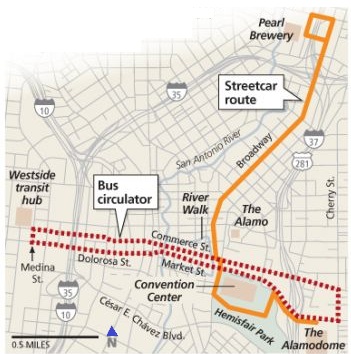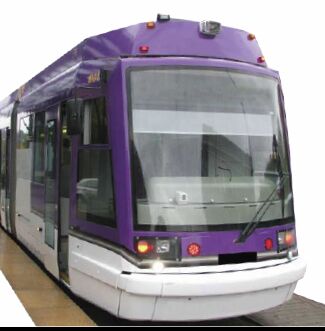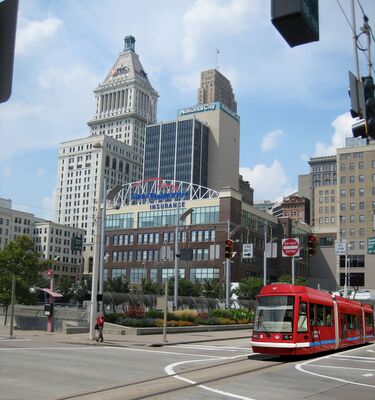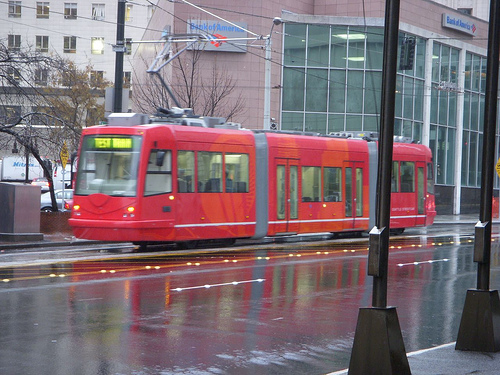
Produced by the Light Rail Now! Publication Team
This news feature provides an ongoing Weblog of particularly significant developments in public transportation and rail transit.
15 December 2011
Pittsburgh:
North Shore Connector light rail project aims for March opening
 Opening day for Port Authority of Allegheny County's 1.2-mile-long North Shore Connector light rail transit (LRT) extension is fast approaching, reports a November 17th article in the Pittsburgh Post-Gazette.
Opening day for Port Authority of Allegheny County's 1.2-mile-long North Shore Connector light rail transit (LRT) extension is fast approaching, reports a November 17th article in the Pittsburgh Post-Gazette.
[Photo: Pittsburgh Channel]
According to the paper, the project is already 98 percent complete and "on track for the debut of passenger service" next March. A tentative date of March 25th has been announced..
Part of Pittsburgh's LRT system branded as the "T", the extension will allow trains to run from downtown Pittsburgh to the city's north side.
Project manager Keith Wargo has announced that testing of trains on the new line will begin in December. Tests using cutouts matching the profile of new LRT raiclars have already been running. to make sure there are proper clearances on the extension.
"Trucks also have towed pantagraphs, the arm-like devices that connect rail vehicles with the overhead power lines, through the system" reports the Post-Gazette.
The new segment includes a new Gateway Center station, an underground station adjacent to PNC Park, and an elevated station next to Heinz Field.
"The Gateway station is 93 percent complete," reports the article, "and the Romare Bearden mural from the old station has been refurbished and reinstalled." In addition, Wargo said the two brand-new North Shore stations are more than 99 percent complete.
Light Rail Now! NewsLog
URL: http://www.lightrailnow.org/news/n_newslog2011q4.htm#PIT_20111215
Updated 2011/12/15
More on Pittsburgh Public Transport Developments
More on Rail Transit Development...
2 November 2011
San Antonio:
City's daily paper backs streetcar plan as "precursor" to larger light rail
"Building a downtown streetcar line is a risk worth taking" – that was the assessment of an Oct. 19th lead editorial in the San Antonio Express-News, that city's major daily newspaper, with the headline "Streetcars a start toward rail future".
The plan now on the table is an L-shaped route in the city's CBD, developed and put forward in late September by Mayor Julián Castro and Councilman Reed Williams.
As described by a Sep. 24th Express-News report, "The line would move along Broadway, wind through downtown and turn east at HemisFair Park, where it would end at the Robert Thompson Transit Center at the Alamodome."
(See map below.)

[Map: Adapted by LRN from Express-News]
Broadway, a wide boulevard-style street for much of its length, is one of the inner city's most heavily traveled corridors, fronted by retail stores, restaurants, and other commercial establishments, with residential neighborhoods just beyond on both sides.
The streetcar line would be double-tracked, according to the Sep. report.
In addition, Mayor Castro is proposing "a bus circulator that would travel east and west through downtown, between the Thompson station and VIA's planned West Side Multimodal Center, in the city's former train depot on Medina Street", according to the Express-News article.
The plan to finance the project includes $40 million from the city, using a portion of a 2007 bond savings reserved for HemisFair Park, combined with assessments collected from the River North Tax Increment Reinvestment Zone and other city money.
"The city also will pursue commitments from developers along Broadway to invest in the corridor and spur more economic investment" reported the paper, which further noted that "In August, Bexar County commissioners allotted $55 million of advanced transportation district funds to VIA's $180 million, five-year plan, which includes the streetcar line, revitalization of two downtown transit centers, and two Park & Rides."
However, the article notes, "The county vote was contingent on both VIA and the city providing additional funds – $70 million from VIA, based on its bonding capacity, and $55 million from the city."
How the $15 million reduction in the city's commitment would affect this is not explained.
The new L-shaped route proposal "combines economic development with transportation" Mayor Castro told the paper, calling the route the one "we believe stands the best chance for success."
 In its endorsement, the Express-News noted that "The $180 million streetcar plan is a less-expensive precursor to light rail and an overdue attempt to recast the transportation culture in San Antonio in preparation for a future that undoubtedly will include higher gas prices and most likely will feature tougher air pollution standards.
In its endorsement, the Express-News noted that "The $180 million streetcar plan is a less-expensive precursor to light rail and an overdue attempt to recast the transportation culture in San Antonio in preparation for a future that undoubtedly will include higher gas prices and most likely will feature tougher air pollution standards.
[Simulation of San Antonio streetcar: VIA]
>>
The community has to start somewhere now or start from scratch when local roadways and airways hit crisis levels. As a beginning, the streetcars, which can be merged with a rail system later, will do nicely.
The Broadway-HemisFair Park route will connect the growing complex at the Pearl, the coming wave of apartment units on Broadway and the nascent redevelopment effort at HemisFair Park.
[...]
The birthing process has been somewhat traumatic, but any effort to launch a rail system was destined to be controversial and difficult.
A key feature to this start-up is that it is being done with local dollars and a plan that brings value even if federal dollars can't be obtained to finance future expansion.
VIA officials are confident that federal funds will be accessible; critics see the nation's dire fiscal woes as a daunting roadblock for mass transportation funding.
But if those transportation dollars aren't available, federal highway funds will be scarce as well.
The need for public transportation is clear if San Antonio wants to nurture downtown as the vibrant jewel it is today and if community leaders want to invest in smart inner-city development that prepares this community for the future.
<<
Light Rail Now! NewsLog
URL: http://www.lightrailnow.org/news/n_newslog2011q4.htm#SA_20111102
Updated 2011/11/02
More on San Antonio Public Transport Developments
More on Rail Transit Development...
More on Streetcars...
27 October 2011
Cincinnati columnist:
"Anti-Streetcar Measure Is a Trojan Horse"
 "Here they go again."
That's how columnist Kevin Osborne began his commentary this past August 3rd on the latest effort by rail transit opponents to bollix rail development in Cincinnati, as posted online to the CityBeat alternative newspaper.
"Here they go again."
That's how columnist Kevin Osborne began his commentary this past August 3rd on the latest effort by rail transit opponents to bollix rail development in Cincinnati, as posted online to the CityBeat alternative newspaper.
[Graphic: Cincy Streetcar]
"Just as Far Right conservatives in Congress created a crisis over the federal debt ceiling so they could advance their true goal of nibbling away at Social Security and Medicare," writes Osborne, "so are fringe factions closer to home using a backdoor maneuver to block Cincinnati's mass transit options for the next decade or more."
>>
If you listen to the groups collecting signatures to place a proposed charter amendment on the November ballot, all they're trying to accomplish is stopping the city's planned $95 million streetcar system.
The amendment is being pushed by the Coalition Opposed to Additional Spending and Taxes (COAST) and the NAACP's local chapter, the same groups that placed another amendment on the ballot in 2009.
That effort sought to require a public vote before taxpayer money was used for any rail-related project within Cincinnati.
After a hard-fought campaign, voters rejected the amendment, 56 percent to 44 percent.
This time around, the groups are lobbying for a far more restrictive measure, one that would prevent even private investment in any type of passenger rail systems – not just streetcars but also commuter rail and even the hillside trams known as inclines – until Dec. 31, 2020.
<<
"In short," says Osborne", "it's overreaching and short-sightedness taken to an absurd extreme."
And "If you don't believe me, just take a look at the wording being used on petitions" he challenges.
>>
The proposed amendment's first section states: The City shall not spend or appropriate any money on the design, engineering, construction or operation of a Streetcar System, or any portion thereof. Further, the City shall not incur any indebtedness or contractual obligations for the purpose of financing, designing, engineering, construction or operating of a Streetcar System, or any portion thereof.
The phrasing means city officials would be prohibited from spending money on anything related to preparing any type of rail transit. Further, it restricts the city from accepting federal grants for such projects, along with entering into public-private partnerships or even accepting private investment, should some benefactor decide to pick up the project's entire tab. Incredible.
The proposed amendment's second section states: This Amendment applies from the date it is certified to the Charter, and will continue in effect until Dec. 31, 2020. This Amendment will have no force or effect after Dec. 31, 2020.
As succinctly put by Cincinnatians for Progress, the pro-streetcar group that opposes the amendment, the arbitrary 10-year ban on preparation is designed to force new transit planning to start from square one in 2021. Because permanent infrastructure requires many years to develop, this wording would guarantee Cincinnati sees no rail-based transit for a generation.
The proposed amendment's third section states: For purposes of this Amendment, (i) the term "Streetcar System" means a system of passenger vehicles operated on rails constructed primarily in existing public rights of way, (ii) the term "City" includes without limitation the City, the Manager, the Mayor, the Council, and the City's various boards, commissions, agencies and departments and (iii) the term "money" means any money from any source whatsoever.
Any. Source. Whatsoever.
Because of the broad definition, all types of passenger rail that use Cincinnati streets or rights-of-way would be prohibited. That means any eventual plans for commuter rail lines along the Eastern Corridor or to places like Sharonville and West Chester would be barred.
Moreover, it makes it virtually impossible to revive the sort of light rail system that once was envisioned running from Mason southward through Cincinnati and on to the Cincinnati/Northern Kentucky International Airport in Hebron, like the one included in the 2001 "Metro Moves" plan.
In other words, the amendment would go a long way toward killing regional rail projects, as well.
<<
Osborne also charges that "People who have been collecting signatures on behalf of COAST and the NAACP have been purposefully underplaying the amendment's impact, telling residents it just affects the streetcar project. Baloney."
Drilling down into possibilities of motivationa and strategy, he focuses first on the extremist-right component of the anti-rail coalition.
>>
It's not a surprise that COAST – which is Libertarian to the extreme, dislikes government involvement in most sectors of society and hates mass transit – would try to pull the wool over voters' eyes.
One COAST leader, Anderson Township resident Chris Finney, is a crackerjack attorney who's made a lucrative career from suing governments and promoting ultra-conservative legislation.
Make no doubt, the wording in the proposed amendment isn't a mistake; it's there for a reason and COAST realizes its full impact.
<<
Osborne then turns to the issue of why in the world groups supposedly championing the interests of black Cincinnatians and advocating "progressive" causes would back such a virulent and disonest attack on mass transit development.
>>
The real question is why would Christopher Smitherman and Michelle Edwards of the local NAACP go along with such a far-reaching initiative?
Do they honestly think the predominantly African-American residents of poor, inner-city neighborhoods like Avondale and Evanston wouldn't be well-served by having cheap transportation to job centers in Mason and Northern Kentucky? And just what do you think a gallon of gasoline will be selling for on Dec. 31, 2020?
Let's make it clear – it's not cheap to drive, no matter what type of vehicle you might own.
According to figures complied by the Automobile Association of America (AAA), the total average cost of driving a car during a single year is $9,859, or 49.3 cents per mile.
The figure includes costs such as gas, maintenance and tires, along with insurance, license, registration and taxes.
And if you're driving a sport utility vehicle (SUV), it costs $12,598 annually, or 63 cents per mile.
If you're driving a minivan, it costs $10,716 annually, or 53.6 cents per mile.
<<
Next, Osborne addresses one of the extremist-right's most overowked (and woverworn) myths in their attack on mass transit – that somehow public transport (and rail in particularly) is supposedly utterly unique in receiving public subsidies to help sustain it:
>>
One of the reasons groups like COAST say they dislike mass transit is that it is publicly subsidized.
But make no mistake, highways and airports also are heavily subsidized, it's just not as apparent to the casual observer.
A 2002 analysis by the Ohio Association of Rail Passengers found that 54 percent ($32.3 billion) of the U.S. Transportation Department's funding was allocated for highways, 23 percent ($14 billion) was allocated for airports and less that 10 percent ($5 billion) went toward mass transit.
Also, user fees only account for about 60 percent of highway spending by all levels of government; the rest comes from non-users.
In its analysis, the association states, "As has been noted by well known conservative Paul Weyrich, of the Free Congress Foundation, the current transportation system, dominated by highway and air transportation, is by no means a free market outcome. Rather it is the result of massive and sustained government intervention on behalf of these two modes."
<<
"So," concludes Osborne, "even if you're opposed to Cincinnati's current streetcar project, anyone with an eye toward the future should quickly reject the charter amendment that likely will be put on the November ballot.
It could have consequences that will scar the city and its development potential for years to come."
Light Rail Now! NewsLog
URL: http://www.lightrailnow.org/news/n_newslog2011q3.htm#CIN_20112027
Updated 2010/10/27
More on Cincinnati Public Transport
More on Rail Transit Political Campaigns...
More on Policy & Political Issues ...
14 October 2011
Seattle:
Development of citywide streetcar system advances
Seattle, Washington — Streetcar-type light rail transit (LRT) development is advancing fairly briskly in the major West Coast city,
according to recent summary reports from Rail Transit Online (posted by the APTA Streetcar and Heritage Trolley website).
 Seattle's South Lake Union Streetcar line has achieved goals of both improving mobility and
attracting adjacent economic development – thus inspiring local planners and officials to pursue development of much larger streetcar network.
Seattle's South Lake Union Streetcar line has achieved goals of both improving mobility and
attracting adjacent economic development – thus inspiring local planners and officials to pursue development of much larger streetcar network.
[Photo: Choconancy (Flickr)]
Last year, on 26 October 2010, reports RTO,
the governing board of Sound Transit (which so far has operated express buses, the Sounder regional passenger rail service, and the Seattle Link LRT system) "approved funding not to exceed $132.8 million for the 2.5-mi. (4 km) First Hill Streetcar project."
The First Hill line (the basic concept of which was first proposed by Light Rail Now technical consultant Lyndon Henry in early 2001) is planned to operate "along a meandering route between the Chinatown/ International district, First Hill and the Link light rail station on Capitol Hill, with a service every 10 min, during peak periods and every 20 min. at other times", according to RTO.
The article provides additional details:
>>
The City of Seattle will be in charge of design, construction, equipment and operations.
Sound Transit will retain farebox income unless the city contributes to the cost of operations and maintenance, in which case revenues can be proportionally shared.
Still to be decided is the location of the yard and shop: two sites have been environmentally cleared.
Construction should start next year [2011] followed by revenue service in 2013.
<<
The streetcar project replaces a Link LRT (higher-speed semi-metro) station initially planned for First Hill that proved too expensive and difficult to install as part of Central Link's northern extension.
Further information on the First Hill Streetcar project is available at the following link:
http://seattlestreetcar.com/firsthill.asp
According to another RTO summary, in August 2011, Seattle's City Council is pursuing its own plans for an extensive citywide streetcar network.
The Council's Transportation Committee "has unveiled a 20-year Transit Master Plan focused on four corridors that could potentially support high-capacity transportation modes such as streetcars or bus rapid transit" reports RTO.
>>
They include a seven-mile (11.3 km), eight-stop streetcar route from Loyal Heights to King Street Station via Ballard and Fremont, another starting in the University District and serving the Roosevelt neighborhood to downtown, from Colman Dock to Capitol Hill and Madison Park, and from downtown to lower Queen Anne or to a connection with the South Lake Union and First Hill streetcars.
The plan includes a total of 15 corridors, most of which would see enhanced bus service. The determining factors are ridership demand, land use, terrain and whether existing transit needs to be augmented.
<<
The RTO report quotes Seattle Department of Transportation official Tony Mazzella who affirmed, as summarized by the article, that "the focus will be on funding the highest-priority corridors."
"On these corridors, rail is a very strong alternative" Mazzella told the online news site seattlepi.com (formerly the Post-Intelligencer daily newspaper).
"Over time, rail is going to be a more cost-effective way to meet a certain demand. That's partially because you're meeting the demand with fewer labor costs and you're spending less in capturing new riders" he emphasized.
Light Rail Now! NewsLog
URL: http://www.lightrailnow.org/news/n_newslog2011q4.htm#SEA_20111014
Updated 2010/10/14
More on Seattle Public Transport
More on Rail Transit Development...
More on Streetcars...
5 October 2011
USA:
Obesity of population may drastically reduce capacity of public transit systems
United States — The legally authorized passenger capacity of the entire US transit industry could be reduced dramatically if new federal average passenger weight guidelines go into effect.
"It's official: The federal government says more overweight Americans are squeezing onto buses, and it may have to rewrite bus safety rules because of it" reports a March 1st article in USA Today, which says that the US Federal Transit Administration (FTA, which the article erroneously names as the "Federal Transit Authority") "proposes raising the assumed average weight per bus passenger from 150 pounds to 175 pounds, which could mean that across the country, fewer people will be allowed on a city transit bus."
Given that there are many thousands of buses across the nation, that would seem to imply that the entire US transit bus fleet capacity may be suddenly downsized.
The federal agency, which regulates how much weight a bus can carry, "also proposes adding an additional quarter of a square foot of floor space per passenger" says the article.
The changes are being sought "to acknowledge the expanding girth of the average passenger" the agency says.
"This change is really just a bow to reality" suggested Joseph Schwieterman, described as someone "who studies bus ridership as director of the Chaddick Institute for Metropolitan Development at DePaul University in Chicago."
"With no small number of bus passengers tipping the scale at 200 pounds or more, this is much more realistic" Schwieterman claimed.
Ironically, other studies have noted that many Americans are overweight because the difficulties of mobility in suburban areas and the lack of convenient and accessible transit, plus the lack of safe pedestrian facilities, all conspire to make people dependent on personal motor vehicles rather than the healthier exercise of walking.
The news article provides further background on the passenger weight issue:
>>
Current federal guidelines on average passenger weight are based on surveys in 1960-62 of what Americans weighed then.
Today, the Centers for Disease Control and Prevention says, the average weight is 194.7 pounds for men 20 and older and 164.7 pounds for women that age range. "FTA believes that 175 pounds is an appropriate average weight to assume for testing buses," the agency says.
Even with the changes, bus riders would be "lighter" than other passengers – at least by federal standards.
The Federal Aviation Administration, which oversees airline travel, gauges average passenger weight at 190 pounds in the summer and 195 pounds in the winter.
The Coast Guard's assumed average weight is 185 pounds for boats and ferries.
<<
In another bitter irony, the threat of passenger capacity reduction comes just as transit agencies nationwide are increasingly stressed trying to cope with higher operating costs and more passengers, desperate for a les costly alternative to driving:
>>
The proposed change comes as more people are turning to public transportation to avoid skyrocketing fuel prices.
It was published in the Federal Register last week, just as an American Public Transportation Association [APTA] study predicted an additional 670 million passenger trips per year on transit systems if gas prices reach an average $4 a gallon nationally.
At $5 a gallon, the association predicts 1.5 billion more passenger trips.
<<
APTA president William Millar warns that the economic recession has left the nation's transit systems unprepared for that kind of ridership increase.
Without additional investment, he says, "people will be stranded on the street corner or in the stations."
"It's too soon to know what effect the proposed weight changes could have for riders – whether reducing the number of passengers per bus or changing bus design" concludes the article.
Light Rail Now! NewsLog
URL: http://www.lightrailnow.org/news/n_newslog2011q4.htm#USA_20111005
Updated 2010/10/05
More on Policy & Political Issues ...
NewsLog for 2011: Jul.-Sep.
NewsLog for 2011: Apr.-Jun.
NewsLog for 2011: Jan.-Mar.
NewsLog for 2010: Oct.-Dec.
NewsLog for 2010: Jul.-Sep.
NewsLog for 2010: Apr.-Jun.
NewsLog for 2010: Jan.-Mar.
NewsLog for 2009: Oct.-Dec.
NewsLog for 2009: Jul.-Sep.
NewsLog for 2009: Apr.-Jun.
NewsLog for 2009: Jan.-Mar.
NewsLog for 2008: Oct.-Dec.
NewsLog for 2008: Jul.-Sep.
NewsLog for 2008: Apr.-Jun.
NewsLog for 2008: Jan.-Mar.
NewsLog for 2007: Oct.-Dec.
NewsLog for 2007: Jul.-Sep.
NewsLog for 2007: Apr.-Jun.
NewsLog for 2007: Jan.-Mar.
NewsLog for 2006: Oct.-Dec.
NewsLog for 2006: Jul.-Sep.
NewsLog for 2006: Apr.-Jun.
NewsLog for 2006: Jan.-Mar.
NewsLog for 2005: Oct.-Dec.
NewsLog for 2005: Jul.-Sep.
NewsLog for 2005: Apr.-Jun.
NewsLog for 2005: Jan.-Mar.
NewsLog Archives
Light Rail Now! website
| 